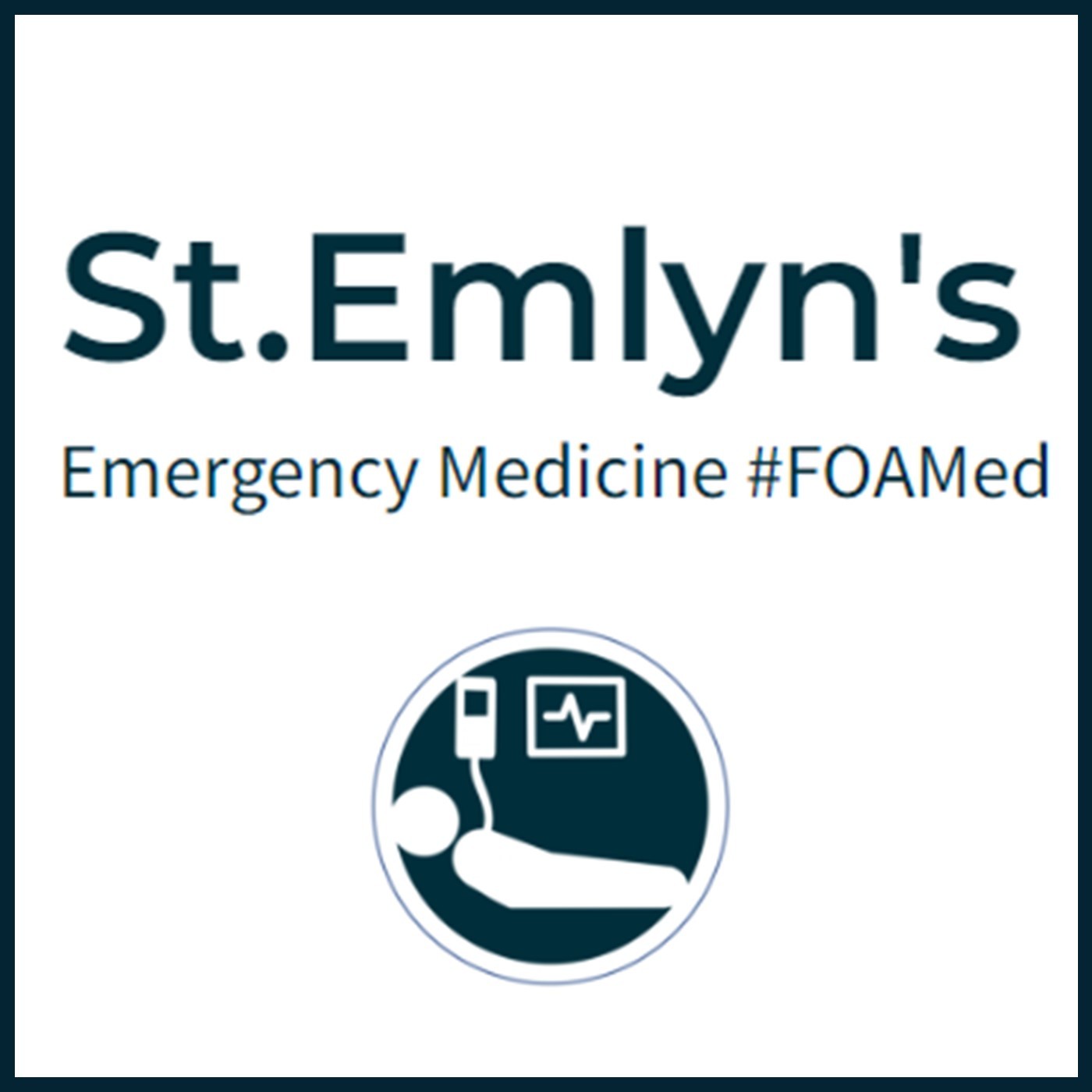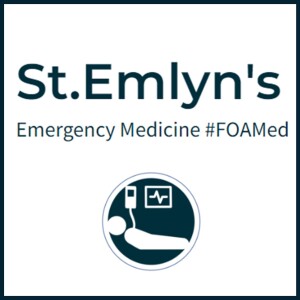
1.3M
Downloads
273
Episodes
A UK based Emergency Medicine podcast for anyone who works in emergency care. The St Emlyn ’s team are all passionate educators and clinicians who strive to bring you the best evidence based education. Our four pillars of learning are evidence-based medicine, clinical excellence, personal development and the philosophical overview of emergency care. We have a strong academic faculty and reputation for high quality education presented through multimedia platforms and articles. St Emlyn’s is a name given to a fictionalised emergency care system. This online clinical space is designed to allow clinical care to be discussed without compromising the safety or confidentiality of patients or clinicians.
Episodes

Friday Jul 28, 2017
Ep 95 - Non accidental injury in the ED.
Friday Jul 28, 2017
Friday Jul 28, 2017
Child Protection in Pediatric Emergency Medicine: A Comprehensive Guide
Child protection is a crucial aspect of pediatric emergency medicine, encompassing the identification and response to suspected cases of child abuse or neglect. As healthcare professionals, it is our responsibility to recognize the signs of abuse, conduct thorough assessments, and approach these sensitive issues with empathy and diligence. This guide provides a comprehensive overview of the key aspects of child protection, including identifying signs of abuse, handling difficult conversations, and collaborating with social services and law enforcement.
Recognizing Signs of Child Abuse
Identifying potential child abuse involves looking for physical, behavioural, and situational signs. Physical indicators include unexplained injuries, such as bruises, burns, or fractures, especially those inconsistent with the child's developmental stage. For instance, long bone fractures in non-mobile children are particularly concerning and should prompt further investigation. Behavioural signs can include excessive fearfulness, withdrawal, or inappropriate sexual behaviours, while situational signs may involve frequent hospital visits or inconsistent explanations for injuries.
Emergency department (ED) staff, including triage nurses, radiographers, and even receptionists, play vital roles in spotting these signs. Their initial observations and interactions can often be the first indicators of potential abuse. It is essential to document all findings meticulously, including descriptions of injuries, the child's behaviour, and parental explanations, to build a comprehensive case for further action.
The Role of the Emergency Department Team
Child protection in the ED is a collaborative effort. Every team member, from doctors to nurses and ancillary staff, contributes to the safeguarding process. Radiological assessments can be particularly revealing, as certain injuries, like rib fractures or metaphyseal lesions, are strong indicators of abuse. These findings, combined with clinical observations, help form a clearer picture of the child's situation.
Thorough documentation is crucial in these cases. It provides a detailed account of the observed injuries and behaviours, which is vital for legal and social services investigations. This documentation should include specific details about the injuries, any discrepancies in the provided history, and observations of the child's and parents' behaviour.
Handling Difficult Conversations
Discussing suspicions of child abuse with parents is challenging and requires a sensitive, non-judgmental approach. It is essential to communicate concerns in a way that prioritizes the child's safety while being respectful to the parents. A suggested approach is to explain that while the observed injuries or behaviours are concerning, the primary goal is to ensure the child's well-being. Phrases such as, "We sometimes see injuries that don’t make sense, and we have to ask more questions to help the children who need it," can help frame the conversation as a protective measure rather than an accusation.
Despite the careful approach, some parents may react defensively or even attempt to leave with the child. In these cases, it is important to remain calm, explain the legal responsibilities, and, if necessary, involve law enforcement to ensure the child's safety. The primary focus should always be on protecting the child and ensuring that proper protocols are followed.
Best Practices for Identifying Non-Accidental Injuries
Non-accidental injuries (NAIs) are a key concern in suspected abuse cases. These injuries, inflicted intentionally by someone else, can include fractures, burns, or bruises that do not match the child's developmental abilities or the provided history. For example, a spiral fracture in a non-mobile child should raise immediate concern.
In addition to physical assessments, radiological evidence is critical in confirming NAIs. Certain injuries, such as specific fracture patterns, are often seen in cases of abuse. However, healthcare providers must also be mindful of other medical conditions that could mimic abuse, such as osteogenesis imperfecta, which can cause brittle bones.
The HEADS Assessment
The HEADS assessment is a valuable tool for evaluating various aspects of a child's life that may indicate risk factors for abuse. HEADS stands for Home environment, Education/employment, Activities, Drug use, Sexuality, and Suicide/depression. This comprehensive approach helps clinicians understand the broader context of a child's situation, including potential stressors and risk factors.
It is important to conduct these assessments in a private setting where the child feels safe to speak openly. For younger children or those who cannot articulate their experiences, careful observation and interaction with the parents can provide crucial insights.
Navigating Cultural and Social Sensitivities
Child protection involves navigating complex cultural and social landscapes. Different cultures have varying norms regarding child-rearing practices, which may be misunderstood as neglect or abuse. It is essential to approach each case with cultural sensitivity and avoid making assumptions based on stereotypes.
Engaging with cultural liaisons or social workers who understand the family's background can help bridge communication gaps and provide context. However, the child's safety must always remain the top priority, regardless of cultural practices.
Collaboration with Social Services and Law Enforcement
Collaboration with social services and law enforcement is often necessary in suspected abuse cases. These agencies play a crucial role in investigating allegations and ensuring the child's safety. Healthcare providers are responsible for reporting their concerns to these authorities, who can then conduct thorough investigations.
Understanding local reporting protocols and mandatory reporting laws is essential for all healthcare providers. Even in the absence of mandatory reporting, it is best practice to err on the side of caution and involve child protection services when there are concerns.
Dealing with the Aftermath
Handling cases of child abuse can be emotionally challenging for healthcare providers. The nature of these cases often leaves providers feeling uncertain and distressed. It is important for healthcare professionals to seek support, whether through colleagues, supervisors, or professional counselling services.
Regular debriefings and reflections on these cases can help improve practices and ensure better preparedness for future cases. Continuous education and training in child protection are also vital for maintaining a high level of competence and confidence in handling these sensitive situations.
Conclusion
Child protection is a shared responsibility that requires vigilance, empathy, and collaboration. As healthcare providers, we are often the first to identify and respond to child abuse cases. By staying informed, following best practices, and approaching these cases with sensitivity and professionalism, we can play a crucial role in safeguarding the well-being of children. At St Emlyn's, we are committed to providing ongoing education and support for healthcare professionals in all aspects of emergency medicine, including child protection. Together, we can make a difference in the lives of vulnerable children.

Tuesday Jul 04, 2017
Ep 95 - Burnout in Critical Care with Liz Crowe
Tuesday Jul 04, 2017
Tuesday Jul 04, 2017
Understanding and Managing Burnout in Critical Care
Introduction
In the high-stakes world of critical care, the topic of burnout has become increasingly prevalent. This blog post explores the complexities of burnout, compassion fatigue, and meaning-making among healthcare professionals, particularly those working in critical care environments. The discussion delves into how these issues manifest, their impact, and practical strategies for addressing them.
Defining Burnout
Burnout is a complex and often misunderstood phenomenon characterized by emotional exhaustion, depersonalization, and a reduced sense of personal accomplishment. It's typically measured using tools like the Maslach Burnout Inventory (MBI), which assesses the risk rather than confirming outright burnout. However, the MBI's broad questions, such as feeling tired after work, can sometimes blur the line between normal stress and clinical burnout.
Context plays a crucial role in understanding burnout. Studies indicate that burnout rates can vary significantly based on geographical location and working conditions. For example, healthcare workers in Poland or Spain may experience different levels of burnout compared to those in the UK, Australia, or the United States, influenced by factors like pay, working hours, and work environment.
The Role of Meaning-Making
Despite the challenges, many healthcare professionals find deep meaning in their work, which can mitigate the effects of burnout. Meaning-making refers to the sense of purpose and value individuals derive from their professional roles. Even when experiencing high levels of burnout, healthcare workers often continue to find their work fulfilling and significant. This intrinsic motivation is crucial for sustaining resilience in demanding work environments.
Research has shown that even when burnout indicators are high, many healthcare professionals report a strong sense of purpose. This paradox highlights that burnout and job satisfaction can coexist. The positive aspects of meaning-making can serve as a buffer against the negative impacts of burnout, helping professionals maintain a sense of fulfillment and motivation.
Understanding Compassion Fatigue
Compassion fatigue differs from burnout and is specifically related to the emotional exhaustion from continuous caregiving. It arises from the intense emotional engagement required in healthcare settings, particularly when dealing with patient suffering. Unlike burnout, which develops over time, compassion fatigue can occur suddenly and can manifest as a diminished capacity to empathize or care.
Fortunately, compassion fatigue is manageable and often reversible with appropriate interventions. Recognizing its signs—such as feelings of helplessness, exhaustion, or a sense of detachment—allows for timely action. Healthcare professionals experiencing compassion fatigue may feel guilty for not meeting their own caregiving standards, which can exacerbate the problem.
Intersection of Burnout and Compassion Fatigue
While distinct, burnout and compassion fatigue often intersect, especially in critical care settings. The intense emotional and physical demands can lead to both conditions simultaneously. For instance, the constant exposure to trauma and suffering can trigger compassion fatigue, which in turn can accelerate the onset of burnout. This interplay complicates the management of these conditions, requiring a comprehensive approach that addresses both emotional and physical well-being.
Strategies for Addressing Burnout and Compassion Fatigue
Individual Strategies:
Healthcare professionals must prioritize self-care to mitigate burnout and compassion fatigue. Essential practices include maintaining a healthy lifestyle, setting boundaries to ensure adequate rest, and engaging in activities that provide joy and relaxation. Mindfulness practices, such as meditation and yoga, can also be beneficial in managing stress and enhancing emotional resilience.
Organizational Strategies:
Organizations have a critical role in supporting their staff. Creating a supportive work environment, offering mental health resources, and ensuring reasonable workloads are fundamental steps. Regular debriefing sessions and fostering a culture of appreciation can significantly improve workplace morale and reduce burnout risk. Additionally, flexible scheduling and adequate staffing are crucial in preventing overwork and ensuring a manageable workload.
Reflective Practice:
Incorporating reflective practices into daily routines helps healthcare professionals process their experiences and emotions. This can be done through journaling, meditation, or team discussions. Reflective practice allows for a deeper understanding of one's emotional responses, helping to build resilience and reduce the risk of emotional exhaustion.
Leadership Role:
Healthcare leaders play a pivotal role in mitigating burnout and compassion fatigue. They should model positive behaviors, such as work-life balance and self-care, and advocate for systemic changes that address the root causes of these issues. Leaders should also foster an environment where staff feel safe to discuss their challenges and seek support.
Team Dynamics:
Positive team dynamics can buffer against stress and reduce the likelihood of burnout. Encouraging open communication and mutual support among team members fosters a supportive work environment. Activities that build team cohesion, such as team-building exercises and regular check-ins, can strengthen relationships and enhance collaboration.
Conclusion
Addressing burnout and compassion fatigue in critical care requires a comprehensive approach that involves both individual and organizational efforts. Recognizing these conditions, understanding their manifestations, and implementing practical strategies are essential steps toward fostering a resilient and supportive healthcare environment. At St Emlyn's, we are committed to exploring these critical issues and sharing strategies to help manage the demands of our profession. By focusing on both personal well-being and systemic changes, we can create a healthier, more sustainable work environment for all healthcare professionals.
